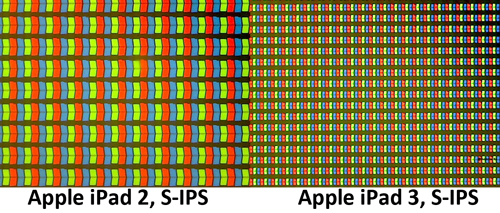Apple's iPad 3, Part 1: The Complete Retina Display And A5X Review
When It Comes To Subpixels, Smaller Is Better
Understanding the nature of a display's potential requires an inspection of the size, shape, and arrangement of individual subpixels. This lets you identify the type of LCD panel and calculate the smallest detail it's capable of rendering. If you're already familiar with our tablet and smartphone coverage, then you know we apply this level of analysis to every mobile device that passes through our lab.
Focusing closer with our lab microscope, we learn two important pieces of information.
First, Apple retains the familiar S-IPS technology on its new Retina display. We know this because the subpixel shape reveals a Samsung IPS design, which makes sense considering the previous iPad displays were also manufactured by Samsung. In short, you'll enjoy the same wide viewing angles on the iPad 3 as its predecessor.
Second, the relatively small size of each subpixel implies a significantly improved color palette. Since every pixel contains three subpixels (red, green, and blue), more pixels allows you to create a wider variety of colors. For example, a bluish-green can be created by turning on the blue and green subpixels, while turning off the red subpixels. The relative bluish tint is achieved by having a brighter blue LED and slightly dimming green. You can only so far, though, because pixels have a fixed range of brightness.
On the iPad 3, specifically, each subpixel measures approximately 30x65 microns. So, you can fit approximately four iPad 3 pixels into the space of a single iPad 2 pixel. Thus, a truer bluish-green hue is possible by turning on four blue subpixels and two green subpixels.
The problem with small pixels is that electrical leakage requires spacing to prevent color blending. Apple overcomes this challenge by cleverly elevating the subpixels off the base LCD circuitry. Though, even with our laboratory-grade microscope tilted at a 30o angle, combined with strong lighting, the gap is still difficult to see. The video above summarizes the technology's details.
Get Tom's Hardware's best news and in-depth reviews, straight to your inbox.
Current page: When It Comes To Subpixels, Smaller Is Better
Prev Page Why We Need (Or At Least Want) HD Tablets... Next Page Better Color And Adobe RGB Performance-
tomfreak the requirement to use adapter to use usb and sd card = minus 50% score for any tablet. Period.Reply -
joytech22 On the CPU and GPU performance page, there's a typo.Reply
When comparing the three iPads, the iPad 2 and iPad 3 are both said to be using PowerVR SGX545 GPUs (core-count is correct) while the table below it comparing SoCs the models are completely different and listed as SGX543.
I smell something fishy, dinner must almost be ready! :D -
amk-aka-Phantom Tomfreakthe requirement to use adapter to use usb and sd card = minus 50% score for any tablet. Period.Reply
My thoughts exactly. I don't care that it outputs 3x FPS over Transformer Prime; the latter can actually integrate into my devices' ecosystem and that's what matters. I'm not buying any tablet or phone without inbuilt memory card reader. -
amk-aka-Phantom Though, of course, it's really sad that Apple is beating Asus on the graphics front. Really, really sad.Reply -
amk-aka-Phantom tc17I have a bridge to sell you if you believe this retina nonsense, on a tiny 10" screen.Reply
After playing around with most hi-end Android devices AND iPhone 4S/iPad 2, I happen to believe this "nonsense". Everything looks so much more hi-res... but that's only Android's fault. When are they going to fix the menu animation lag and make everything more hi-res? ICS kind of did a good job on it, though, and now it actually looks NOTHING like iOS and is beautiful.
Of course, the menu animation lag and low-res icons can't make me shift to Apple, especially now that I run ICS on my netbook (try that, Apple... oh wait, your toy MacOS IS already like a tablet OS, lol) - same way that MacOS's ability to take screenshots of a selected area of the screen can't make me shift from Windows/Ubuntu. It's just not nearly enough to compensate for the important features I'll lose. Sure enough, there're tons of people to whom all of them don't matter and they'll just go with the most hyped thing out there, but I prefer to know what I'm paying for. It's a habit that pays off on the long run. -
killerchickens I wish toms would stop using the bs retina display term considering the ipad 3's display isn't even close to the original standard.Reply -
bernardv 2048x1536 on a 10" screen? This is a joke, 0 value to 99.9% of end users. A fanboy excuse for throwing money away.Reply
The author comments it is suitable for watching movies. Which movie is even available in such a resolution??? For watching movies in your lap on 10", 720p is more than enough.

